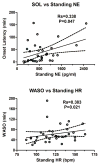Estimation of sleep disturbances using wrist actigraphy in patients with postural tachycardia syndrome
- PMID: 23538032
- PMCID: PMC3700681
- DOI: 10.1016/j.autneu.2013.02.021
Estimation of sleep disturbances using wrist actigraphy in patients with postural tachycardia syndrome
Abstract
Study objectives: Patients with postural tachycardia syndrome (POTS) commonly complain of fatigue, unrefreshing sleep, daytime sleepiness and diminished quality of life. The study objective was to assess sleep quality in POTS patients using wrist actigraphy.
Design: Prospective study with control group.
Methods: Patients with POTS (n = 36) and healthy subjects (n = 36) completed a detailed sleep log and actigraphy for 7 days.
Results: Compared with healthy subjects, POTS patients have more self-reported problems including days with restless sleep (53 ± 30% vs. 21 ± 20%; P<0.001) and tiredness (75 ± 23% vs. 39 ± 27%; P<0.001). Using actigraphy, POTS patients have lower sleep efficiency (73 ± 13% vs. 79 ± 6%; P = 0.01). Actigraphy determined sleep onset latency (SOL) did not vary significantly in the two groups, but subjective SOL was higher in POTS patient (56 ± 66 min vs. 1 3 ± 9 min; P = 0.001). In POTS patients, there was a significant correlation between subjective complaints of tiredness and actigraphic sleep efficiency (Rs = -0.36; R(2) = 0.15; P = 0.01), significant correlations between actigraphic SOL and upright norepinephrine levels (P = 0.040), and between wake after sleep onset and standing heart rate (P = 0.02).
Conclusions: POTS patients have more sleep-related symptoms and poor sleep efficiency. The pattern of subjective vs. objective SOL mismatch is suggestive of sleep-state misperception. High norepinephrine correlated with actigraphic SOL, and this activation of the stress system may contribute significantly to a hyperarousal state with consequent insomnia, poor mental and physical health in POTS patients.
Keywords: Actigraphy; Autonomic; Human; Orthostatic tachycardia; Sleep.
Copyright © 2013 Elsevier B.V. All rights reserved.
Conflict of interest statement
None
Figures




Comment in
-
Objective sleep parameters in patients with postural tachycardia syndrome by actigraphy.Auton Neurosci. 2013 Dec;179(1-2):172. doi: 10.1016/j.autneu.2013.10.004. Epub 2013 Oct 21. Auton Neurosci. 2013. PMID: 24177036 No abstract available.
Similar articles
-
Objective sleep parameters in patients with postural tachycardia syndrome by actigraphy.Auton Neurosci. 2013 Dec;179(1-2):172. doi: 10.1016/j.autneu.2013.10.004. Epub 2013 Oct 21. Auton Neurosci. 2013. PMID: 24177036 No abstract available.
-
Sleep disturbances and diminished quality of life in postural tachycardia syndrome.J Clin Sleep Med. 2011 Apr 15;7(2):204-10. J Clin Sleep Med. 2011. PMID: 21509337 Free PMC article.
-
Objective Sleep Assessments in Patients with Postural Tachycardia Syndrome using Overnight Polysomnograms.J Clin Sleep Med. 2016 May 15;12(5):727-33. doi: 10.5664/jcsm.5806. J Clin Sleep Med. 2016. PMID: 26951415 Free PMC article.
-
Practical aspects of actigraphy and approaches in clinical and research domains.Handb Clin Neurol. 2019;160:371-379. doi: 10.1016/B978-0-444-64032-1.00024-2. Handb Clin Neurol. 2019. PMID: 31277861 Review.
-
Postural tachycardia syndrome: a heterogeneous and multifactorial disorder.Mayo Clin Proc. 2012 Dec;87(12):1214-25. doi: 10.1016/j.mayocp.2012.08.013. Epub 2012 Nov 1. Mayo Clin Proc. 2012. PMID: 23122672 Free PMC article. Review.
Cited by
-
Sleep and immune function among people living with human immunodeficiency virus (HIV).AIDS Care. 2021 Sep;33(9):1196-1200. doi: 10.1080/09540121.2020.1770180. Epub 2020 Jun 1. AIDS Care. 2021. PMID: 32482093 Free PMC article.
-
What is brain fog? An evaluation of the symptom in postural tachycardia syndrome.Clin Auton Res. 2013 Dec;23(6):305-11. doi: 10.1007/s10286-013-0212-z. Epub 2013 Sep 3. Clin Auton Res. 2013. PMID: 23999934 Free PMC article.
-
Sleep disturbances and autonomic dysfunction in patients with postural orthostatic tachycardia syndrome.Front Neurol. 2014 Jul 7;5:118. doi: 10.3389/fneur.2014.00118. eCollection 2014. Front Neurol. 2014. PMID: 25071706 Free PMC article.
-
Sleep actigraphy results and HIV health outcomes in an urban HIV clinic sample.Psychol Health Med. 2025 Feb;30(2):357-367. doi: 10.1080/13548506.2024.2407444. Epub 2024 Sep 21. Psychol Health Med. 2025. PMID: 39305254
-
Pediatric Disorders of Orthostatic Intolerance.Pediatrics. 2018 Jan;141(1):e20171673. doi: 10.1542/peds.2017-1673. Epub 2017 Dec 8. Pediatrics. 2018. PMID: 29222399 Free PMC article. Review.
References
Publication types
MeSH terms
Grants and funding
LinkOut - more resources
Full Text Sources
Other Literature Sources
Medical

